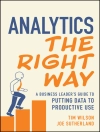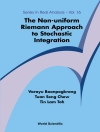Data Science Fundamentals with R, Python, and Open Data
Introduction to essential concepts and techniques of the fundamentals of R and Python needed to start data science projects
Organized with a strong focus on open data, Data Science Fundamentals with R, Python, and Open Data discusses concepts, techniques, tools, and first steps to carry out data science projects, with a focus on Python and RStudio, reflecting a clear industry trend emerging towards the integration of the two. The text examines intricacies and inconsistencies often found in real data, explaining how to recognize them and guiding readers through possible solutions, and enables readers to handle real data confidently and apply transformations to reorganize, indexing, aggregate, and elaborate.
This book is full of reader interactivity, with a companion website hosting supplementary material including datasets used in the examples and complete running code (R scripts and Jupyter notebooks) of all examples. Exam-style questions are implemented and multiple choice questions to support the readers’ active learning. Each chapter presents one or more case studies.
Written by a highly qualified academic, Data Science Fundamentals with R, Python, and Open Data discuss sample topics such as:
* Data organization and operations on data frames, covering reading CSV dataset and common errors, and slicing, creating, and deleting columns in R
* Logical conditions and row selection, covering selection of rows with logical condition and operations on dates, strings, and missing values
* Pivoting operations and wide form-long form transformations, indexing by groups with multiple variables, and indexing by group and aggregations
* Conditional statements and iterations, multicolumn functions and operations, data frame joins, and handling data in list/dictionary format
Data Science Fundamentals with R, Python, and Open Data is a highly accessible learning resource for students from heterogeneous disciplines where Data Science and quantitative, computational methods are gaining popularity, along with hard sciences not closely related to computer science, and medical fields using stochastic and quantitative models.
Inhoudsopgave
Preface xiii
About the Companion Website xvii
Introduction xix
1 Open-Source Tools for Data Science 1
1.1 R Language and RStudio 1
1.2 Python Language and Tools 5
1.3 Advanced Plain Text Editor 8
1.4 CSV Format for Datasets 8
2 Simple Exploratory Data Analysis 13
2.1 Missing Values Analysis 13
2.2 R: Descriptive Statistics and Utility Functions 15
2.3 Python: Descriptive Statistics and Utility Functions 17
3 Data Organization and First Data Frame Operations 23
3.1 R: Read CSV Datasets and Column Selection 24
3.2 R: Rename and Relocate Columns 36
3.3 R: Slicing, Column Creation, and Deletion 38
3.4 R: Separate and Unite Columns 45
3.5 R: Sorting Data Frames 49
3.6 R: Pipe 55
3.7 Python: Column Selection 59
3.8 Python: Rename and Relocate Columns 67
3.9 Python: Num Py Slicing, Selection with Index, Column Creation and Deletion 69
3.10 Python: Separate and Unite Columns 81
3.11 Python: Sorting Data Frame 85
4 Subsetting with Logical Conditions 99
4.1 Logical Operators 99
4.2 R: Row Selection 101
5 Operations on Dates, Strings, and Missing Values 127
5.1 R: Operations on Dates and Strings 129
5.2 R: Handling Missing Values and Data Type Transformations 141
5.3 R: Example with Dates, Strings, and Missing Values 154
5.4 Pyhton: Operations on Dates and Strings 165
5.5 Python: Handling Missing Values and Data Type Transformations 173
5.6 Python: Examples with Dates, Strings, and Missing Values 182
6 Pivoting and Wide-long Transformations 195
6.1 R: Pivoting 197
6.2 Python: Pivoting 202
7 Groups and Operations on Groups 221
7.1 R: Groups 222
7.2 Python: Groups 244
8 Conditions and Iterations 271
8.1 R: Conditions and Iterations 272
8.2 Python: Conditions and Iterations 284
9 Functions and Multicolumn Operations 307
9.1 R: User-defined Functions 308
9.2 R: Multicolumn Operations 316
9.3 Python: User-defined and Lambda Functions 330
10 Join Data Frames 347
10.1 Basic Concepts 348
10.2 Python: Join Operations 369
11 List/Dictionary Data Format 393
11.1 R: List Data Format 395
11.2 R: JSON Data Format and Use Cases 410
11.3 Python: Dictionary Data Format 422
Questions 443
Index 447
Over de auteur
Marco Cremonini is Assistant Professor with the Department of Social and Political Sciences at the University of Milan, Italy. He is Academic Editor and Board Member of PLOS ONE and his current research interests are focused on computational network and agent-based models of propagation and behavior.












